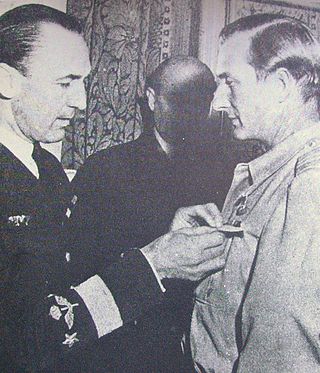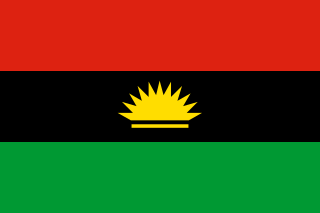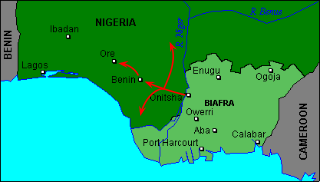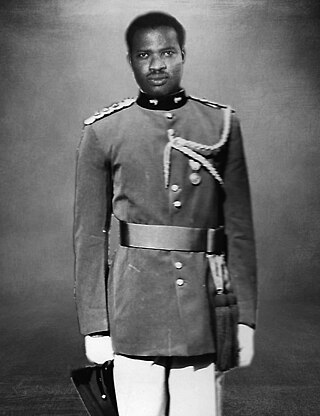
In military terminology, a missile is a guided airborne ranged weapon capable of self-propelled flight usually by a jet engine or rocket motor. Missiles are thus also called guided missiles or guided rockets. Missiles have five system components: targeting, guidance system, flight system, engine and warhead. Missiles come in types adapted for different purposes: surface-to-surface and air-to-surface missiles, surface-to-air missiles, air-to-air missiles, and anti-satellite weapons.

Count Carl Gustaf Ericsson von Rosen was a Swedish pioneer aviator, humanitarian, and mercenary pilot. He flew relief missions in a number of conflicts as well as combat missions for Finland and Biafra. His flights for the Biafran Air Force were notable for using the small Malmö MFI-9 in a ground attack role.

The Nigerian Civil War, also known as the Nigerian–Biafran War or the Biafran War, was a civil war fought between Nigeria and the Republic of Biafra, a secessionist state which had declared its independence from Nigeria in 1967. Nigeria was led by General Yakubu Gowon, while Biafra was led by Lieutenant Colonel Chukwuemeka "Emeka" Odumegwu Ojukwu. Biafra represented the nationalist aspirations of the Igbo ethnic group, whose leadership felt they could no longer coexist with the federal government dominated by the interests of the Muslim Hausa-Fulanis of Northern Nigeria. The conflict resulted from political, economic, ethnic, cultural and religious tensions which preceded the United Kingdom's formal decolonisation of Nigeria from 1960 to 1963. Immediate causes of the war in 1966 included a military coup, a counter-coup, and anti-Igbo pogroms in Northern Nigeria. Control over the lucrative oil production in the Niger Delta also played a vital strategic role, and was a factor in the strong French support for Biafra.

A ranged weapon is any weapon that can engage targets beyond hand-to-hand distance, i.e. at distances greater than the physical reach of the user holding the weapon itself. The act of using such a weapon is also known as shooting. It is sometimes also called projectile weapon or missile weapon because it typically works by launching solid projectiles ("missiles"), though technically a fluid-projector and a directed-energy weapon are also ranged weapons. In contrast, a weapon intended to be used in hand-to-hand combat is called a melee weapon.

The Movement for the Actualization of the Sovereign State of Biafra (MASSOB) is a secessionist movement in Nigeria, associated with Igbo nationalism, which supports the recreation of an independent state of Biafra. It was founded in 1999 and is led by an Indian-trained lawyer Ralph Uwazuruike, with headquarters in Okwe, in the Okigwe district of Imo State.

The flag of Biafra, used by the Republic of Biafra during the Nigerian Civil War (1967–1970), consists of a horizontal tricolour of red, black, and green, charged with a golden rising sun over a golden bar. The eleven rays of the sun represent the eleven former provinces of Biafra. The rays are typically long and slender with the lowest rays being nearly horizontal and the remaining rays spread evenly between.

The Malmö Flygindustri MFI-9 Junior was a light aircraft produced in Sweden in the 1960s. The aircraft was also produced under licence in West Germany as the Bölkow Bo 208.

The fall of Enugu was a military conflict between Nigerian and Biafran forces in September and October 1967 during the Nigerian Civil War which centered around Enugu, the capital of the secessionist Republic of Biafra. Nigerian federal forces had made Enugu's capture a priority shortly after war broke out, but their advance stalled at Nsukka. Biafran leader Odumegwu Ojukwu attempted to distract the Nigerian Army by initiating an invasion of Nigeria's Mid-Western Region in August, but the offensive was brought to a halt. Lieutenant Colonel Theophilus Danjuma took charge of the Nigerian forces at the Nsukka front and prepared to advance on Enugu with seven battalions of the 1st Division. Enugu was garrisoned by one brigade led by Colonel Alexander Madiebo and poorly armed civilians called into service. Danjuma decided to launch an offensive with his forces spread over a broad front to make it more difficult for the Biafrans to block them along major roads as had happened up to that point.
The Operation UNICORD was an offensive launched by the Nigerian Army at the beginning of the Nigerian Civil War. It involved the capture of 6 major Biafran towns near their northern border.
The Invasion of Port Harcourt was a military conflict between Nigerian and Biafran military forces.

The Midwest Invasion of 1967 codenamed Operation Torch. was a military operation between Nigerian and Biafran military forces during the Nigerian Civil War. The invasion began on August 9 when 3,000 Biafran soldiers led by General Victor Banjo crossed the River Niger Bridge into Asaba. Upon reaching Agbor, the Biafrans split up. With the 12th Battalion moving west capturing Benin City and Ore, the 18th Battalion swung south, taking Warri, Sapele and Ughelli, while the 13th Battalion headed north for Auchi, Agenebode and Okene. Simultaneously, a plot to capture Mid-Western Governor David Ejoor at his home in Benin failed. Nevertheless, the Biafrans, meeting virtually no resistance, had seized the entire Mid-Western Region in less than 12 hours.
The Abagana Ambush was an ambush by Biafran guerrilla troops led by Major Jonathan Uchendu that wiped out the Nigerian 2 Division. Of the 6,000 Nigerian troops ambushed, only a very small number survived, including the 2nd Division's commander, General Murtala Muhammed.
Operation Leopard was a military operation conducted against Biafran troops defending Umuahia. No fighting took place inside Umuahia but the area surrounding it was heavily devastated by the Nigerian offensive. Umuahia was finally captured by Nigerian troops on April 22, 1969.
Operation Hiroshima was a military operation conducted by the Biafran 4th Commando Brigade in an attempt to recapture Onitsha from the Nigerian 2nd Division. The operation ultimately resulted in failure and ended in the deaths of numerous mercenaries and Biafran soldiers.
The Nigerian National War Museum in Umuahia showcases the military history of Nigeria with relics form the Biafra-Nigerian Civil War. It has a collection of tanks, armored vehicles, ships, and aircraft all from Nigeria or the defunct Republic of Biafra. Almost all tanks and AFLs are Biafran and all aircraft are Nigerian. It holds in it the evidence of the internal war in Nigeria from 1967 to 1970. The museum is considered a heritage site.

The Biafran Armed Forces (BAF) were the military of the Nigerian secessionist state of Biafra, which existed from 1967 until 1970.

Ejike Ebenezer Obumneme Aghanya was a military officer and electrical engineer who served in the Nigerian Army and the Biafran Armed Forces, retiring as a colonel. Accused of involvement in the 1966 Nigerian coup d'état he was arrested and imprisoned without trial until the outbreak of the Nigerian Civil War where he served on the side of Biafra, holding key positions in the Biafran Armed Forces. He was the head of the Biafran Agency for Research and Production (RAP) which produced bombs, rockets, missiles, as well as ammunition, armored vehicles, telecommunication gadgets and petroleum refineries among others for the Biafran Armed Forces. Later he was the Chief of Staff of the Biafran Organisation of Freedom Fighters (BOFF) which was the guerrilla warfare and special operations arm of the Biafran Armed Forces. He also served as Battalion Commander, 44th Electrical and Mechanical Engineer Battalion Biafran Army and later Brigade Commander of the 58th Brigade of 12th Infantry Division Biafran Army during the war.

Gordian Obumneme Ezekwe was a Nigerian inventor, mechanical engineer and former federal Minister of Science and Technology under Ibrahim Babangida from 1989 to 1991. As the head of the Rocket Group of the Biafran Research and Production Directorate, he was notable for supervising the invention of the Biafran rocket and building a refinery for producing fuel, kerosene and diesel during the Nigerian Civil War. He was also involved in the production of the Ogbunigwe. He was a former Director of the Projects Development Agency (PRODA), first Vice Chairman and Chief Executive of the National Agency For Science and Engineering, Infrastructure (NASENI), and founder of Science Equipment Development Institute (SEDI). Prof. Gordian Ezekwe was the first Nigerian PhD in Mechanical Engineering (1959)
Biafran Research and Production or Research and Production (RAP) was a scientific and engineering research institution of the Republic of Biafra that researched and manufactured military technology for the Biafran Armed Forces during the Nigerian Civil War.










